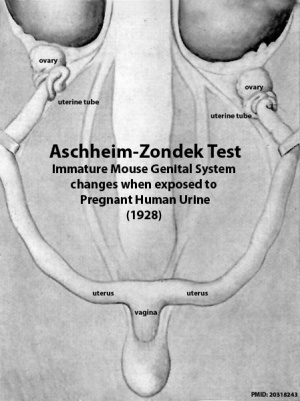Aschheim-Zondek Test 1928 Movie
| Embryology - 27 Apr 2024 |
|---|
| Google Translate - select your language from the list shown below (this will open a new external page) |
|
العربية | català | 中文 | 中國傳統的 | français | Deutsche | עִברִית | हिंदी | bahasa Indonesia | italiano | 日本語 | 한국어 | မြန်မာ | Pilipino | Polskie | português | ਪੰਜਾਬੀ ਦੇ | Română | русский | Español | Swahili | Svensk | ไทย | Türkçe | اردو | ייִדיש | Tiếng Việt These external translations are automated and may not be accurate. (More? About Translations) |
| <html5media height="650" width="450">File:Aschheim-Zondek Test 1928.mp4</html5media> | This animation shows the basis of the historic 1928 Aschheim-Zondek Pregnancy Test.
The basis of the original historic Aschheim-Zondek[1] test developed in 1928 was to identify the changes in immature female mouse genital system induced by female human urine injected subcutaneously into these immature mice. These changes could be seen by carrying out histology on the mouse ovary to detect follicle development.
This early mouse test was later replaced with a similar, but simpler, urine test using either the frog (Xenopus) or rabbit animal models. Modern home tests use a simple one step urine sample detecting the presence of the hormone human Chorionic Gonadotropin (hCG). Animation based upon original line drawings.[2]
|
Reference
Glossary Links: A | B | C | D | E | F | G | H | I | J | K | L | M | N | O | P | Q | R | S | T | U | V | W | X | Y | Z | Numbers | Symbols | Movies
Cite this page: Hill, M.A. (2024, April 27) Embryology Aschheim-Zondek Test 1928 Movie. Retrieved from https://embryology.med.unsw.edu.au/embryology/index.php/Aschheim-Zondek_Test_1928_Movie
- © Dr Mark Hill 2024, UNSW Embryology ISBN: 978 0 7334 2609 4 - UNSW CRICOS Provider Code No. 00098G
